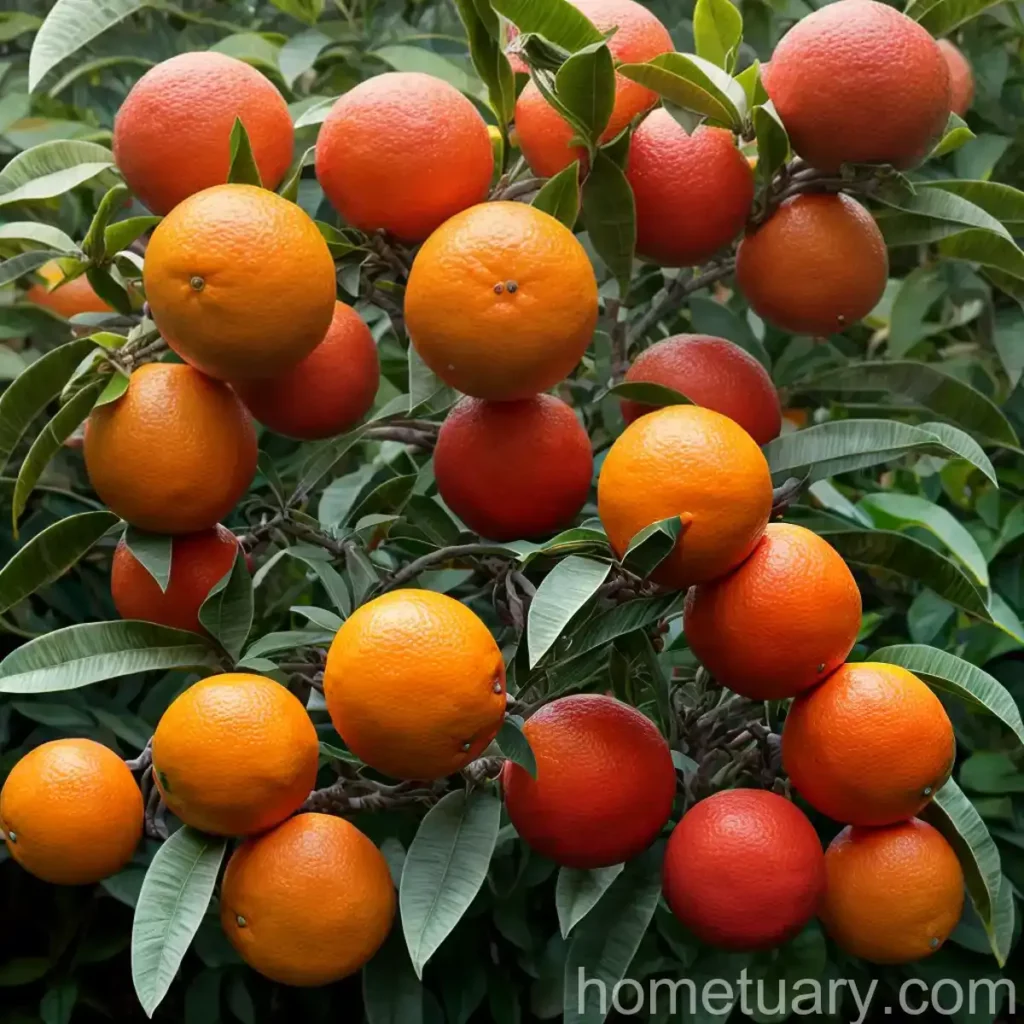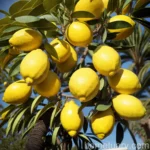Blood Orange (Citrus x sinensis ‘Moro’)
Introduction
The blood orange (Citrus x sinensis ‘Moro’) is a striking citrus fruit with a deep red flesh that sets it apart from traditional oranges. Known for its rich flavor and unique color, the blood orange has gained popularity not only for its culinary uses but also for its nutritional benefits. In this comprehensive guide, we will delve into the characteristics of the blood orange, its cultivation, care tips, common diseases and pests, as well as its uses and fascinating history.
What is a Blood Orange?
The blood orange, scientifically referred to as Citrus x sinensis ‘Moro’, is a type of sweet orange belonging to the citrus fruit family. What distinguishes the blood orange from other oranges is the vibrant crimson or maroon color of its flesh, which is attributed to the presence of anthocyanins, a type of antioxidant pigment. This gives the fruit a unique appearance and imparts a tangy yet sweet flavor.
Key Takeaways
Here are some key takeaways about the blood orange:
- Blood Orange Tree: The blood orange tree is a small evergreen that is prized for its striking and flavorful fruits.
- Moro Blood Orange: The Moro blood orange is one of the most popular varieties, known for its deep red flesh and intense flavor.
- Red-Fleshed Oranges: Blood oranges are often referred to as red-fleshed oranges due to the distinct color of their pulp.
- Moro Orange Cultivation: Growing blood oranges, specifically the Moro variety, requires attention to specific environmental and care requirements.
- Blood Orange Nutrition: Blood oranges are rich in vitamin C, anthocyanins, and other beneficial nutrients.
- Growing Blood Oranges: Cultivating blood oranges involves considerations such as suitable soil, water, sunlight, and fertilizer.
- Blood Orange Varieties: Apart from Moro, there are other blood orange varieties, each with its unique characteristics and flavors.
- Moro Orange Tree Care: Proper care and maintenance are essential for nurturing healthy blood orange trees.
- Blood Orange Juice: These oranges are popular for making vibrant and tangy juices.
- Citrus x sinensis Moro: Citrus x sinensis ‘Moro’ is the botanical name for the Moro blood orange.
Culture
The cultivation of blood oranges, particularly the Moro variety, requires attention to specific cultural practices to ensure successful growth and fruit production.
Uses
Blood oranges are primarily grown for their fruit, which is used in various culinary applications. The vibrant color and distinct flavor of the fruit make it ideal for juicing, creating marmalades, and adding a unique touch to salads, desserts, and beverages. In addition to culinary uses, blood oranges are also valued for their ornamental appeal, with their striking appearance adding visual interest to landscapes and gardens.
Water
Proper irrigation is crucial for the healthy growth of blood orange trees. Although these trees are relatively drought-tolerant once established, consistent watering is essential, especially during the flowering and fruiting stages. Adequate moisture is necessary to support the development of the fruit and prevent issues such as fruit splitting.
Sunlight
Blood orange trees thrive in full sunlight, requiring at least six to eight hours of direct sunlight daily. Adequate exposure to sunlight promotes robust growth, flowering, and fruit development. Insufficient sunlight can result in reduced fruit production and poor fruit quality.
Fertilizer
Fertilization is an important aspect of blood orange tree care. A balanced fertilizer with a higher ratio of nitrogen is generally recommended for citrus trees, promoting healthy foliage and fruit production. However, it is essential to follow specific soil test recommendations and adjust the fertilizer application based on the tree’s individual needs.
Soil
Blood oranges prefer well-draining soil with a slightly acidic to neutral pH. Rich, fertile soil with good aeration is beneficial for the development of healthy root systems and overall tree vigor. Additionally, avoiding waterlogged or compacted soil is crucial to prevent root rot and other soil-related issues.
Pruning
Pruning plays a vital role in shaping blood orange trees, promoting good air circulation, and managing the tree’s overall health and structure. Regular pruning helps remove dead or diseased branches, encourages new growth, and controls the tree’s size. It is essential to use proper pruning techniques and tools to prevent damage to the tree.
Propagation
Blood oranges can be propagated through various methods, including grafting and budding. These techniques allow for the propagation of specific varieties, ensuring desirable traits and characteristics in the resulting trees. Propagation should be carried out with care and attention to detail to promote successful establishment and growth.
Container Popularity
The compact size and ornamental value of blood orange trees make them popular choices for container cultivation. Growing blood oranges in containers allows individuals with limited space to enjoy the beauty and fruitfulness of these trees on patios, balconies, or in small gardens.
Botanist’s Tips
– When selecting a container for blood orange trees, choose a large, sturdy pot with adequate drainage holes to promote healthy root development and prevent waterlogging.
– Regularly monitor moisture levels in the container and adjust the watering frequency based on environmental conditions and the tree’s specific needs.
– Use a well-draining potting mix formulated for citrus trees to provide essential nutrients and support optimal root health in container-grown blood orange trees.
Common Diseases
Like many fruit-bearing trees, blood orange trees are susceptible to certain diseases that can affect their overall health and productivity. Recognizing and addressing these diseases is crucial for maintaining the well-being of the trees and ensuring a bountiful harvest.
Disease Diagnosis
The following are common diseases that can affect blood orange trees:
- Citrus Canker (Xanthomonas citri subsp. citri): This bacterial disease causes characteristic lesions on leaves, fruits, and stems, leading to defoliation, fruit drop, and overall decline in tree health.
- Citrus Black Spot (Guignardia citricarpa): This fungal disease causes dark, sunken lesions on fruit, reducing its marketability and potentially impacting tree vigor.
- Phytophthora Root Rot (Phytophthora spp.): Phytophthora root rot can lead to root damage, poor nutrient uptake, and ultimately, tree decline if left unmanaged.
- Citrus Tristeza Virus (CTV): This viral disease affects the vascular system of citrus trees, leading to stunted growth, leaf discoloration, and potential tree death.
Common Pests
In addition to diseases, blood orange trees can also be affected by various pests that can compromise tree health and fruit quality. Common pests include:
- Citrus Leaf Miner (Phyllocnistis citrella): The larvae of this moth species create distinctive serpentine mines on citrus leaves, potentially impacting tree vigor and photosynthetic capacity.
- Asian Citrus Psyllid (Diaphorina citri): This insect pest can transmit the bacterium associated with citrus greening disease (huanglongbing), a devastating citrus disease that affects overall tree health and fruit quality.
Botanist’s Tips
– Regularly inspect blood orange trees for symptoms of diseases and pests, including leaf spots, lesions, unusual leaf curling, and pest activity.
– Implement appropriate cultural and integrated pest management practices, including proper sanitation, pruning, and the use of beneficial insects, to minimize the impact of diseases and pests on blood orange trees.
Fun Facts
- The distinctive red color of blood oranges develops due to the presence of anthocyanins, which are a type of antioxidant pigment not commonly found in citrus fruits.
- Blood oranges are believed to have originated in the Mediterranean region, where they have been cultivated for centuries.
- In addition to their culinary uses, blood oranges are also valued for their potential health benefits, attributed to their high vitamin C content and antioxidant properties.
Links to External Resources
In this extensive guide, we have explored the fascinating world of blood oranges, from their cultivation and care to common diseases and pests that can affect their health. Whether you are an avid gardener or a citrus enthusiast, understanding the unique characteristics and requirements of blood orange trees is essential for fostering their growth and enjoying the bountiful harvest of their vibrant and flavorful fruits.















